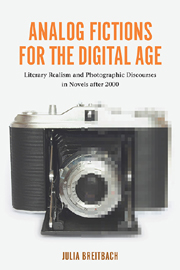 Analog Fictions for the Digital Age
Analog Fictions for the Digital Age Published online by Cambridge University Press: 05 April 2013
Little understanding of the significance of new image technologies will be gained without relating them to photographic culture.
—Martin Lister, The Photographic Image in Digital CultureTechnology and Terminology: Analog, Digital, and Analogo-Digital Photography
With the rise of digital photographic practices in the 1990s an intense scholarly discussion set in, prompted by the need to come to terms with, to understand, and to label a new technology. An early and frequently cited touchstone in this context is William J. Mitchell's (1992) book-length study The Reconfigured Eye: Visual Truth in the Post-Photographic Era. Published at the onset of digital image processing as a widespread practice, The Reconfigured Eye bestows great enthusiasm on a still-nascent technology and is to no small extent concerned with technological exegesis and the practical details of computer-based image production. The book's main focus, however, is on the future of photography and its claim to documentary verification in an increasingly digital environment. One of the many merits of Mitchell's study is that it systematically lays out the differences between old and new technologies of image-making. The author frames analog photography and digital imagery in terms of a dichotomy. He speaks, for instance, of a “basic technical distinction between analog (continuous) and digital (discrete) representations” (4).
To save this book to your Kindle, first ensure no-reply@cambridge.org is added to your Approved Personal Document E-mail List under your Personal Document Settings on the Manage Your Content and Devices page of your Amazon account. Then enter the ‘name’ part of your Kindle email address below. Find out more about saving to your Kindle.
Note you can select to save to either the @free.kindle.com or @kindle.com variations. ‘@free.kindle.com’ emails are free but can only be saved to your device when it is connected to wi-fi. ‘@kindle.com’ emails can be delivered even when you are not connected to wi-fi, but note that service fees apply.
Find out more about the Kindle Personal Document Service.
To save content items to your account, please confirm that you agree to abide by our usage policies. If this is the first time you use this feature, you will be asked to authorise Cambridge Core to connect with your account. Find out more about saving content to Dropbox.
To save content items to your account, please confirm that you agree to abide by our usage policies. If this is the first time you use this feature, you will be asked to authorise Cambridge Core to connect with your account. Find out more about saving content to Google Drive.